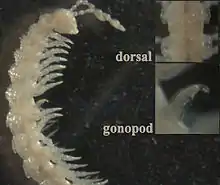| Brachydesmus superus | |
|---|---|
 | |
| Scientific classification | |
| Domain: | Eukaryota |
| Kingdom: | Animalia |
| Phylum: | Arthropoda |
| Subphylum: | Myriapoda |
| Class: | Diplopoda |
| Order: | Polydesmida |
| Family: | Polydesmidae |
| Genus: | Brachydesmus |
| Species: | B. superus |
| Binomial name | |
| Brachydesmus superus Latzel, 1884 | |
| Synonyms[1] | |
| |

Brachydesmus superus, sometimes called the flat millipede,[2][3] is a species of millipede in the family Polydesmidae.[4][5] Its specific name is from the Latin word for "above, upper,"[6] because it lives in the upper soil layer.[7]
Appearance
A light brown or grey flat-backed millipede. Adults are up to 1 cm (0.39 in) long, with 19 segments (including the telson), unlike most other adults in the family Polydesmidae, which usually have 20 segments.[8] Accordingly, adults in this genus have two fewer legs than most polydesmid adults have: Females have only 29 pairs of legs, and males have only 28 pairs of walking legs, excluding one pair of gonopods.[9][10]
Distribution
Native to Europe, also found in New England.[11]
Behaviour
Lives in damp terrestrial habitats.[12] Female lays about 50 eggs in spring or summer in a dome-shaped nest. The first-staged larva has seven segments and three pairs of legs; it moults six times (sometimes seven for males) before reaching adult size.[13]
They are known as a pest in sugar beet fields.[14]
References
- ↑ "MilliBase - Brachydesmus superus Latzel, 1884". www.millibase.org.
- ↑ Adams, Charles R.; Early, Michael P.; Bamford, Katherine M. (November 8, 2008). Principles of Horticulture. Routledge. ISBN 9780750686945 – via Google Books.
- ↑ Adams, Charles; Early, Mike; Brook, Jane; Bamford, Katherine (August 7, 2014). Principles of Horticulture: Level 2. Routledge. ISBN 9781317937777 – via Google Books.
- ↑ Stephenson, J. W. (May 1, 1960). "The biology of Brachydesmus Superus (Latz.) Diplopoda". Annals and Magazine of Natural History. 3 (29): 311–319. doi:10.1080/00222936008655772 – via Taylor and Francis+NEJM.
- ↑ "The Transactions of the Cave Research Group". Cave Research Group. November 8, 1973 – via Google Books.
- ↑ Skeat, Walter William (November 8, 1895). "A Concise Etymological Dictionary of the English Language". Harper & Bros. – via Google Books.
- ↑ L?kke, Hans; Gestel, Cornelis A. M. van (May 5, 1998). Handbook of Soil Invertebrate Toxicity Tests. Wiley. ISBN 9780471971030 – via Google Books.
- ↑ "Brachydesmus superus Latzel, 1884 | British Myriapod and Isopod Group". www.bmig.org.uk.
- ↑ Blower, J. Gordon (1985). Millipedes : keys and notes for the identification of the species. Linnean Society of London, Estuarine and Brackish-water Sciences Association. London: Published for the Linnean Society of London and the Estuarine and Brackish-Water Sciences Association by E.J. Brill. ISBN 90-04-07698-0. OCLC 13439686.
- ↑ Mesibov, Robert. "External Anatomy of Polydesmida: Body plans". myriapodology.org. Retrieved 2022-02-20.
- ↑ "Brachydesmus superus Latzel, 1884". www.gbif.org.
- ↑ English, Mary (1976). "New Records of Millipedes from Munster, Ireland". The Irish Naturalists' Journal. 18 (12): 341–347. JSTOR 25537965 – via JSTOR.
- ↑ Gratwick, M. (December 6, 2012). Crop Pests in the UK: Collected edition of MAFF leaflets. Springer Science & Business Media. ISBN 9789401114905 – via Google Books.
- ↑ Cooke, D. A.; Scott, J. E. (December 6, 2012). The Sugar Beet Crop. Springer Science & Business Media. ISBN 9789400903739 – via Google Books.